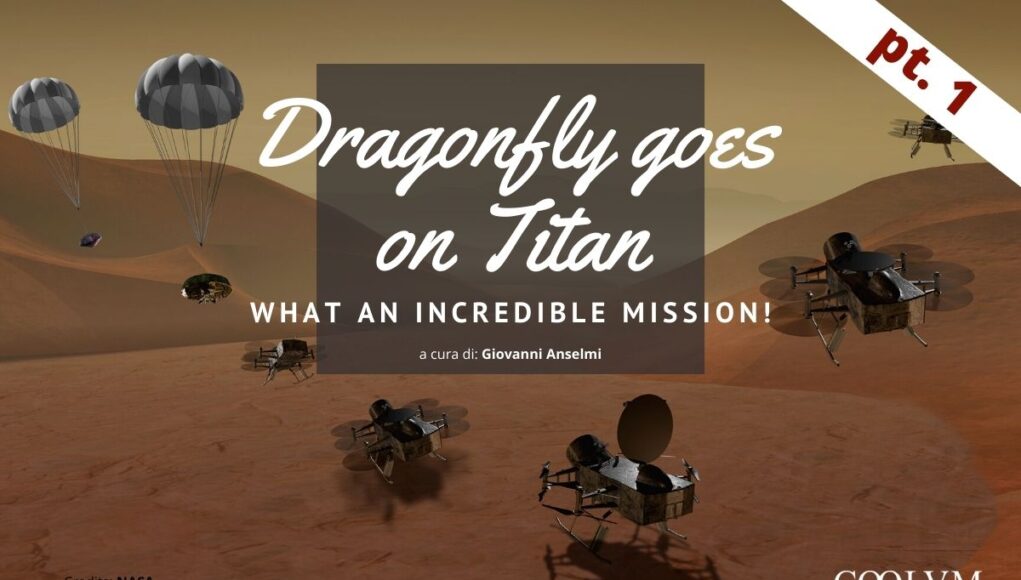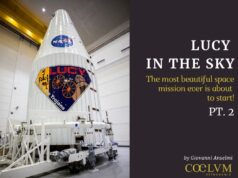Indice dei contenuti
On Earth it is 9:00 a.m. UT on January 14, 2005 when the small Huygens probe is released from the Cassini mothership and plunges into the atmosphere of Titan at an altitude of 1200 km
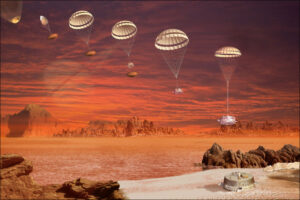
Huygens parachutes down for two and a half hours, measuring atmospheric pressure, temperatures, electrical properties, humidity, wind speed, and direction.
Equipped with a microphone, Huygens also records the first ambient sounds from another celestial body. The spacecraft descends through an atmosphere formed by hydrocarbon and nitrogen smog, and lower down a troposphere furrowed by a few but dense cloud formations, possibly thunderstorms, and characterized by fog formations at medium altitudes, crossed by electrical discharges.
The slow descent gives Huygens plenty of time to photograph the approaching surface, and surprisingly the panorama of Titan recalls the orography of our mountains, with quiet valleys crossed by rivers and streams.
We can glimpse sinuous channels of ice organized in a dense network of main branches and smaller branches, which seem to flow into vast basins similar to large lakes, bordered by coastlines with a marked profile.
And then, islands and slabs of lighter-colored soils, perhaps shoals or sandy shores, emerging from darker basins near the coastlines, over which misty formations stand out.
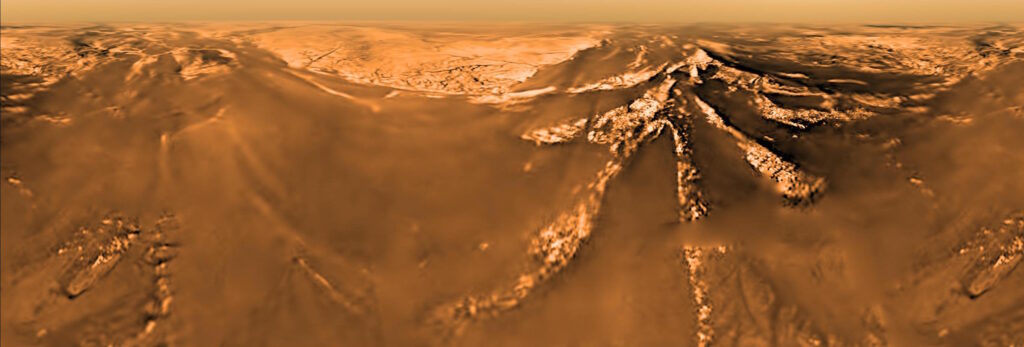
But the resemblance is only apparent…
Titan is, in fact, a world totally alien to Earth and, as far as we know, also very different from other solid bodies in the Solar System.
Instead of liquid water, Titan has liquid methane; instead of silicate rocks, Titan has rocks of compact ice; instead of dust, Titan has a regolith of ice and smog; instead of lava flows, Titan has volcanoes that erupt ice.
A very strange world that reveals its secrets only with great difficulty!
All this Huygens saw and photographed, as he descended cradled by Titan’s winds.
Until, after two and a half hours of travel, he touches down in what looks like the wet bed of a stream, largely composed of water ice, full of smooth pebbles that lie, eroded at the base by the flow of water, on an apparently soft but solid surface, perhaps the beach of one of the many river channels or drains.
Another 72 minutes and the probe’s batteries run out
And Huygens has been there ever since, for 17 years. Or maybe not, Titan is such a living, violent world that a flood or methane rains could have swept her away, buried in one of the many lakes of hydrocarbons…
A little sorry, honestly. That spacecraft was brave, and it gave us the first important insights into a truly alien world, 1.5 billion miles away from home.
Of course, the photographs it left us are of poor quality (the camera technology was that of 15 years earlier) and deteriorated by brutal compression algorithms (a price to be paid to the temporariness of communications and the short time available for transmission), but the mission is still a technological and scientific success.
But Huygens will not be alone for long. Another Earth probe is preparing to land on Titan and to reap the benefits of its sacrifice…
Dragonfly on the way!
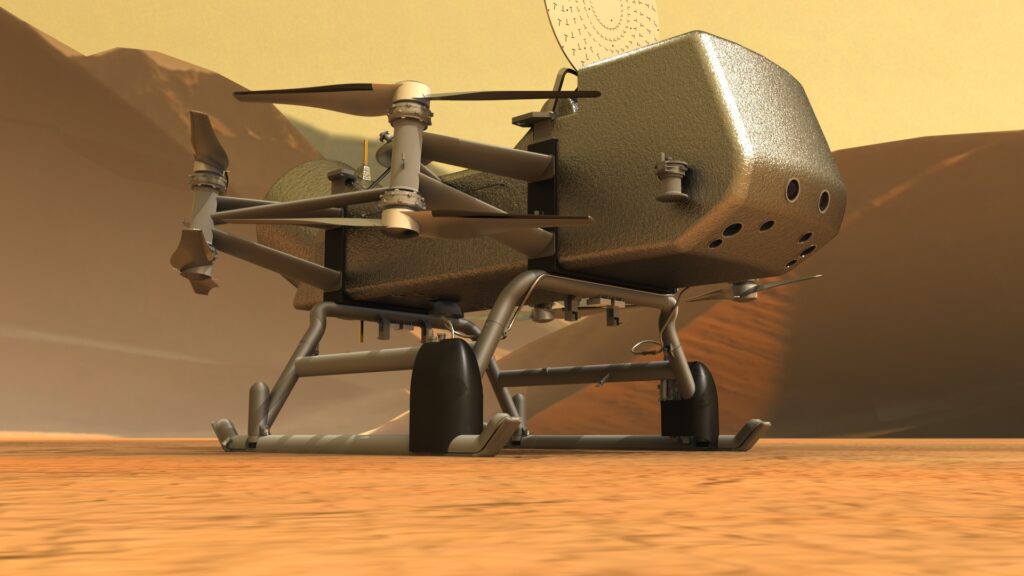
Credits: NASA/Johns Hopkins APL
Among the many moons in the Solar System, Titan – Saturn’s largest moon, the second largest in the Solar System – stands out for its unique characteristics, and for the possibility of finding extraterrestrial life forms there, past or present.
Larger than the planet Mercury, its orbit around Saturn places it about 1.4 billion kilometers from the Sun (i.e., about 10 times farther than Earth), so its average temperature is about -180°C.
Its atmosphere, dense and opaque in the visible spectrum, is composed largely of nitrogen and methane.
Methane on Earth is one of the products of the life processes of organisms and occurs naturally in gaseous form. On Titan, however, where the surface pressure is 50% higher than on Earth, methane is liquid and, just like water on our planet, forms clouds and rains, fills lakes and rivers.
Titan is the only satellite in the Solar System that possesses a thick atmosphere and liquids flowing on its surface. It even has a hydrological system similar to Earth’s, although it rains methane instead of water. Wind and rain have created surface features similar to those found on Earth and, like Earth, Titan manifests the alternation of seasons.
At this point the question arises: could Titan host, or have hosted, some form of life?
It depends. Life as we know it needs three things: an energy source such as sunlight, a liquid solvent such as water, and organic substances, a wide variety of carbon-based compounds that build proteins for life as we know it.
Before life arose on Earth, our atmosphere was very different. There was almost no oxygen and much more methane. In the sunlight, these molecules formed organic chemicals that then rained down on the ground. We don’t know exactly what those chemicals were, but when combined with water and energy they probably formed the primordial soup from which life arose.
We can’t travel back in time and see exactly what happened in the past, but fortunately, there is a current place with a similar atmosphere: Titan!
So we just have to go and see! Yes, but how?
We had a chance in 2005 with the little Huygens, but its brief existence only served to make us even more curious.
And Saturn, it’s not exactly around the corner…
Fortunately, NASA has found the funding to put together a true sci-fi mission, giving birth to the idea of a giant drone that will go “from flower to flower” on Titan’s surface.
We won’t be sending an ordinary lander, then. Planetary landers move very slowly and can only explore a small region of the worlds they visit, but Titan’s low gravity and dense atmosphere will allow Dragonfly, as it has obviously been named, to take flight and make leaps of tens of kilometers.
Dragonfly is certainly not a garden-variety drone.
At 3 meters long and weighing 500 kilograms, it’s more like a small car, with four arms that each support two rotors stacked on top of each other. Each of the eight rotors will be about one meter in diameter.
The aircraft will be able to travel at about 10 meters per second and will be able to fly up to 4 km altitude. This will allow it to make short flights from one point to another on the surface. Each flight will be meticulously planned but will have to be done autonomously, as a radio command sent from Earth would take more than 80 minutes to reach the drone.
Titan’s gravity is about one-seventh that of Earth, slightly weaker than the gravity of our Moon. With an atmosphere four times denser than Earth’s – about the pressure you feel one meter underwater – conditions are therefore perfect for flight.
A human being with flapping wings could probably fly to Titan!








